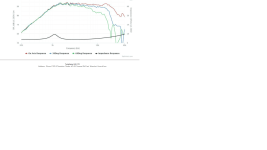I started my studies on sound systems and decided to start studying frequencies and cuts for that purpose.
I would like to know if my line of reasoning is correct.
When we analyze a graph of SPL by frequency of a speaker, when we find a place where a reasonably flat line extends horizontally (without large valleys or peaks) it means that it is where the speaker behaves best (at those frequencies) and that it would be the best place to make a frequency cut with filters.
When we "merge" with another speaker we must observe the flat horizontal line in the two and find where they intersect in the best possible way on the SPL by frequency graph.
We should never mix frequencies, for example the woofer goes up to 250hz, the midranger goes from 200hz to 3000hz and the tweeter goes from 2500hz to 20khz. (Fictitious values)
Looking at the graphs of sun by tweeter frequency, I have trouble knowing where the cutoff will be.
I would like to know if my line of reasoning is correct.
When we analyze a graph of SPL by frequency of a speaker, when we find a place where a reasonably flat line extends horizontally (without large valleys or peaks) it means that it is where the speaker behaves best (at those frequencies) and that it would be the best place to make a frequency cut with filters.
When we "merge" with another speaker we must observe the flat horizontal line in the two and find where they intersect in the best possible way on the SPL by frequency graph.
We should never mix frequencies, for example the woofer goes up to 250hz, the midranger goes from 200hz to 3000hz and the tweeter goes from 2500hz to 20khz. (Fictitious values)
Looking at the graphs of sun by tweeter frequency, I have trouble knowing where the cutoff will be.
Looking at the graphs of sun by tweeter frequency, I have trouble knowing where the cutoff will be.
Can you rephrase that sentence?
I suggest you take a look at AllenB's two part guide to choosing the crossover frequency:
https://www.diyaudio.com/community/...igning-crossovers-without-measurement.189847/
See post #2 and post #3.
When I look at the graph of spl by frequency of a tweeter I can't find the same thing that I see in the midranger and wooder... the graph is always growing.Can you rephrase that sentence?
I suggest you take a look at AllenB's two part guide to choosing the crossover frequency:
https://www.diyaudio.com/community/...igning-crossovers-without-measurement.189847/
See post #2 and post #3.
I will read what you sent soon
If you're talking about the tweeter from Ali Express which you were looking at for a three way speaker, its frequency response is very unusual in the way it keeps rising: most tweeters don't do that. That tweeter would need some extra parts in the crossover to make it behave; I wouldn't use it and I don't know enough to explain why it behaves as it does.
Have a look at at the frequency responses for tweeters such as Vifa BC25TG, Morel CAT378 and Peerless DA25: they're all reasonably flat and easy to work with. They're all viewable at the Parts Express web site.
Geoff
Have a look at at the frequency responses for tweeters such as Vifa BC25TG, Morel CAT378 and Peerless DA25: they're all reasonably flat and easy to work with. They're all viewable at the Parts Express web site.
Geoff
I was going to post a screen shot of that tweeter (if that's the one you're talking about), but the website is blocked by my browser for 'malicious software'.
Compare its response with the frequency responses for these tweeters, all widely used in many successful projects: all quite smooth, all sound good : Vifa BC25TG, Morel CAT378 and Dayton DC28. If I recall correctly, the one you're thinking of had a rising response after about 3,000Hz, although it was at least relatively steady.
Geoff
Compare its response with the frequency responses for these tweeters, all widely used in many successful projects: all quite smooth, all sound good : Vifa BC25TG, Morel CAT378 and Dayton DC28. If I recall correctly, the one you're thinking of had a rising response after about 3,000Hz, although it was at least relatively steady.
Geoff
Attachments
This is well worth reading, should answer many of you questions :
https://www.diyaudio.com/community/...igning-crossovers-without-measurement.189847/
Geoff
https://www.diyaudio.com/community/...igning-crossovers-without-measurement.189847/
Geoff
I will read this entire article,Vale a pena ler, deve responder a muitas de suas perguntas:
https://www.diyaudio.com/community/...igning-crossovers-without-measurement.189847/
Geoff
Do you know how I can quote the last answer on this forum?
Whenever I see the last answer there is never "quote" next to "Like"
When I look at the graph of spl by frequency of a tweeter I can't find the same thing that I see in the midranger and wooder... the graph is always growing.
I will read what you sent soon
Perhaps you should have made clear, in this new post, that you were referring to a particular tweeter.
As Geoff says, tweeters don't normally have a rising response, i.e., an SPL that rises with frequency.
Regarding where to place your "frequency cuts" in a 3-way speaker, there must be sufficient frequency range between the high pass frequency (Fh) and the low pass frequency (Fl). This ensures a good combined response.
Pick Fh and divide it by 8 to get Fl. Alternatively you can pick Fl and multiply by 8 to get a good Fh.
One example of a good choice of crossover frequencies is: Fh = 3000 Hz and Fl = 375 Hz.
Do you know how I can quote the last answer on this forum?
The forum is set up to discourage members from quoting the entire preceding post. That's why there is no "Quote option on the last post.
You can highlight the relevant passage in the post that you want to quote (not all of the post please) and you will see a clickable "Quote tag appear.
Make sure you have first clicked open your reply box before highlighting and clicking on the quote tag.
Last edited:
I will read this entire article
As I said in post #2 above, the relevant sections to read in the article are posts #2 and #3.
Make sure you have first clicked open your reply box before highlighting and clicking on the quote tag.
Sorry, that part is not necessary!
Well, I'm very happy to learn that! That problem has always bugged me.You can highlight the relevant passage in the post that you want to quote (not all of the post please) and you will see a clickable "Quote tag appear.
To the original poster - I'd suggest using DSP or an active adjustable crossover* and a microphone (or phone / tablet based spectrum analyser) so that you can make changes and see the result instantly.
There are many layers of complexity with designing a crossover, so the first one will probably not be satisfactory for you.
* E.g. Behringer DCX2496 LE or CX3400. Or a PC based system (I don't know what to recommend for a beginner here).
Last edited:
I would like if my thinking on the matter was correct...Perhaps you should have made clear, in this new post, that you were referring to a particular tweeter.
As Geoff says, tweeters don't normally have a rising response, i.e., an SPL that rises with frequency.
Regarding where to place your "frequency cuts" in a 3-way speaker, there must be sufficient frequency range between the high pass frequency (Fh) and the low pass frequency (Fl). This ensures a good combined response.
Pick Fh and divide it by 8 to get Fl. Alternatively you can pick Fl and multiply by 8 to get a good Fh.
One example of a good choice of crossover frequencies is: Fh = 3000 Hz and Fl = 375 Hz.
But now you showed me an error about the tweeter having lines growing
Your thinking is mostly correct. When the drivers have a large overlap range of flat frequency response it usually makes it easier to build a simple crossover filter. It is not always true, because you can use the driver natural drop in frequency output as part of your filter design. For example, a tweeter might have a drop in the low range output at about 12 dB per octave. If we want to achieve a 24 dB crossover, we can simply add a 12 dB electrical filter circuit. The combination of the tweeter natural frequency response and the electrical filter will give us the desired 24 dB crossover shape. To calculate how the natural frequency response of the driver and the electrical filter combine we can use a simulation program such as VituixCAD.
I basically read this entire article and I can say that it opened my mind to an absurd level...This is well worth reading, should answer many of you questions :
https://www.diyaudio.com/community/...igning-crossovers-without-measurement.189847/
Geoff
I've never seen such a good explanation, I took out my notebook and made several notes.
Also give a look to the documents in this post
https://www.diyaudio.com/community/threads/vituixcad-for-newbies.391824/post-7163363
https://www.diyaudio.com/community/threads/vituixcad-for-newbies.391824/post-7163363
- Home
- Loudspeakers
- Multi-Way
- About frequency cuts and graphs


